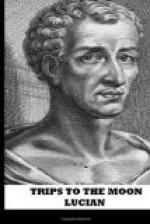{172a} Agathocles.
{172b} Stratonice.
{173} Of Achilles. See the 18th book of the “Iliad.”
{175a} Greek, [Greek].
{175b} Sicyon was a city near Corinth, famous for the richness and felicity of its soil.
{176a} The famous Ager Cynurius, a little district of Laconia, on the confines of Argolis; the Argives and Spartans, whom it laid between, agreed to decide the property of it by three hundred men of a side in the field: the battle was bloody and desperate, only one man remaining alive, Othryades, the Lacedaemonian, who immediately, though covered with wounds, raised a trophy, which he inscribed with his own blood, to Jupiter Tropaeus. This victory the Spartans, who from that time had quiet possession of the field, yearly celebrated with a festival, to commemorate the event.
{176b} A mountain of Thrace. Dion Cassius places it near Philippi. It was supposed to have abounded in golden mines in some parts of it.
{177} When AEacus was king of Thessaly, his kingdom was almost depopulated by a dreadful pestilence; he prayed to Jupiter to avert the distemper, and dreamed that he saw an innumerable quantity of ants creep out of an old oak, which were immediately turned into men; when he awoke the dream was fulfilled, and he found his kingdom more populous than ever; from that time the people were called Myrmidons. Such is the fable, which owed its rise merely to the name of Myrmidons, which it was supposed must come from [Greek], an ant. To some such trifling circumstances as these we are indebted for half the fables of antiquity.
{178a} See Homer’s “Iliad,” book i. 1. 294.
{178b} This was the opinion of Anaxagoras, and is confirmed by the more accurate observations of modern philosophy.
{179} See Pope’s Homer’s “Odyssey,” book x. 1. 113.
{180a} I.e. Such a countenance as he put on when he slew the rebellious Titans.
{180b} See Homer’s “Odyssey,” A. v. 170
{181} Otus and Ephialtes were two giants of an enormous size; some of the ancients, who, no doubt, were exact in their measurement, assure us that, at nine years old, they were nine cubits round, and thirty-six high, and grew in proportion, till they thought proper to attack and endeavour to dethrone Jupiter; for which purpose they piled mount Ossa and Pelion upon Olympus, made Mars prisoner, and played several tricks of this kind, till Diana, by artifice, subdued them, contriving, some way or other, to make them shoot their arrows against, and destroy each other, after which Jupiter sent them down to Tartarus. Some attribute to Apollo the honour of conquering them. This story has been explained, and allegorised, and tortured so many different ways, that it is not easy to unravel the foundation of it.
{182} Jupiter thought himself, we may suppose, much obliged to Phidias for the famous statue which he had made of him, and therefore, in return, complaisantly inquires after his family.




